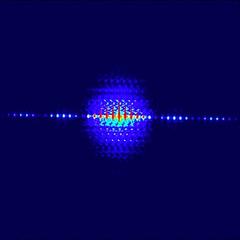URL: https://www.desy.de/news/news_search/index_eng.html
Breadcrumb Navigation
DESY News: Imaging using incoherent light
News
News from the DESY research centre
Imaging using incoherent light
Physicists at the Friedrich Alexander University Erlangen-Nürnberg (FAU), the University of Hamburg and the research facility DESY have succeeded for the first time in revealing tiny structures using an imaging method that relies on the usual diffraction of light, but which does not require the scattered light to be coherent. With conventional imaging methods using the diffraction of coherent light, scientists have to go to considerable lengths to ensure the coherence of the radiation, i.e. the electromagnetic waves must remain in phase during the scattering process. The new method uses incoherent light instead. The process, which has now been demonstrated for the first time using short-wave ultraviolet radiation, stands to revolutionise the methods of diffractive optics and has been published in the journal Nature Physics.

This effect limits the use of coherent diffractive X-ray imaging. “In the case of X-rays, incoherent scattering usually predominates, for example when fluorescent light is produced by photon absorption followed by photon emission,” explains Anton Classen from FAU, who is the principal author of a paper in which the method was first presented theoretically a few months ago. “This creates diffuse background radiation, which has until now been assumed to be unusable for imaging, instead reducing the fidelity of the imaging using coherent methods.”
Now, scientists have used the very same incoherent radiation to record a structure shaped like a benzene ring with the help of diffuse scattered light in the soft X-ray range at DESY’s free-electron laser FLASH. “Our work provides the basis for a fundamentally new approach to X-ray imaging, because our experiment has demonstrated that incoherently scattered photons can be used to reconstruct complex structures at short wavelengths,” explains Raimund Schneider of FAU, the principal author of the paper on the experimental findings.

Free-electron lasers like FLASH or the European X-ray Free-Electron Laser European XFEL have an extremely high brilliance and produce ultra-short X-ray pulses, offering ideal conditions for this new approach to structural analysis, according to Wilfried Wurth, who is the scientific director of FLASH and a professor at the University of Hamburg.
The novel method has a further crucial advantage. “The smaller the structures you want to examine, the larger the proportion of incoherently scattered light,” explains the co-author Ralf Röhlsberger who works at DESY and is also a professor at Hamburg University. “Whereas coherent imaging has problems with the increasing intensity, our method benefits from it.” The method therefore has the potential to fundamentally improve structural analyses in biology and medicine.
Reference: „Quantum Imaging with incoherently scattered light from a free-electron laser“; Raimund Schneider, Thomas Mehringer, Giuseppe Mercurio, Lukas Wenthaus, Anton Classen, Günter Brenner, Oleg Gorobtsov, Adrian Benz, Daniel Bhatti, Lars Bocklage, Birgit Fischer, Sergey Lazarev, Yuri Obukhov, Kai Schlage, Petr Skopintsev, Jochen Wagner, Felix Waldmann, Svenja Willing, Ivan Zaluzhnyy, Wilfried Wurth, Ivan A. Vartanyants, Ralf Röhlsberger, Joachim von Zanthier; Nature Physics, 2017; DOI: 10.1038/nphys4301



